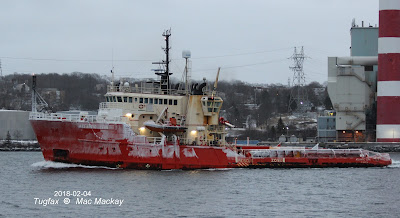It had a varied career until finally going out of documentation some years ago with the name Capt. Mackintire.
As I remember the tug, when it was named the Marjorie L. Winslow.
.On Wednesday February 21, the old tug was in tow of a forty foot workboat which had then come alongside to transfer fuel, on a trip to Annapolis, MD. The workboat struck the tug causing it to take on water, possibly incurring some damage itself.
The USCG responded and towed the work boat called Helen Louise into Portland, ME and another vessel USCGC Reef Shark took the tug in tow. However in the 12 knot winds and six foot seas the tug began to sink and the USCG had to cut the tow line early in the morning of February 23. The tug now rests on the bottom 3 miles off Kennebunk, ME in 158 feet of water. There it is likely to rest.
Virtually unchanged from its original appearance, but painted in classic US tug colours.
Various histories of the tug show up in on line accounts, but all seem incomplete. Here is what I know:
Built for the US Army as ST-725 by Pensacola Shipyard + Engine Co, fitted with 650 bhp Clarke engine.
1945: sold and renamed Utility for Jacksonville Utility Co, Jacksonville, FL.
1964: acquired by St.Philip Coastal Towing Co of Tampa, FL and renamed Marilyn.
1965: renamed Mary St.Philip by the same owners.
1969: bought by Coast Line Towing Corp of Providence, RI and renamed Castle Hill.
1977: acquired by Thames Towboat Co, New London, CT, but not renamed.
1977: acquired by Winslow Marine Inc of Southport and Falmouth, ME renamed Marjorie J. Winslow
2012: bought by Eastport Port Authority, Eastport, ME and renamed Capt. Mackintire.
2014: sold to private owners and not renamed.
At the Boston Tug Muster and Parade in 1987.
Update#1 February 28. The tow was out of Bar Harbour, and the tug was carrying eight 44 USGal drums of fule for the workboat in addition to 4400 USGal in its own tanks.
USCG will send divers to the site to assess viability of raising / removal of fuel, etc.,
The owner of both boats is reported to be uin the business of buying old boats to use in television and movies.
.















